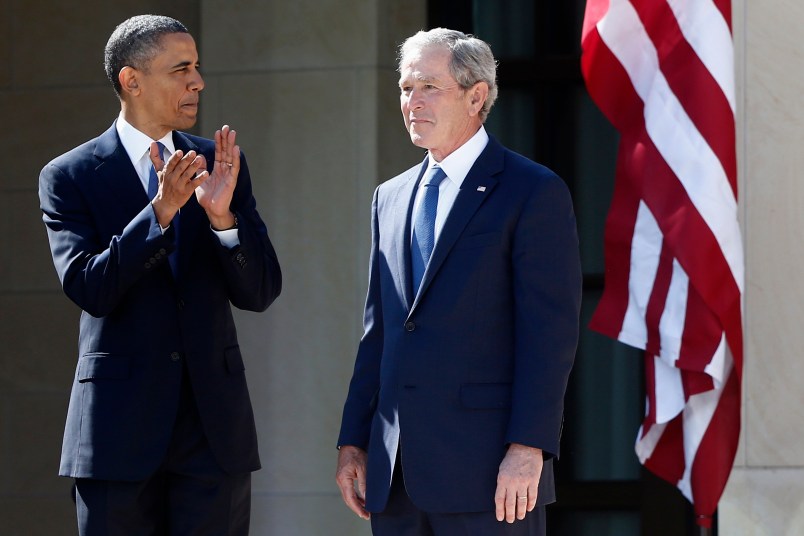For all my many criticisms of him during his presidency, I have come to respect President Bush’s post-presidency. He’s kept out of the toxic political battles that came after he left office. He’s had the confidence or perhaps simply the realism and detachment to leave it to posterity to judge his presidency and not try to duke it out in the 24/7 press cycle like his toxic second Dick Cheney. And there are moments of grace, like the recent 50th anniversary commemoration of the the March on Selma. DC’s Republican leadership stayed away. But Bush was there. One might argue that there was little to be gained by Republicans attending since, in the nature of things, it was not going to be a receptive audience and they would be upstaged infinitely by the iconic symbolism of an African-American President. But the same applies to Bush. And he was there.
But there’s another side to Bush’s post-presidential silence – one often ascribed to the virtues of the Bush clan itself: it is merited and it is wise. For Bush himself.
As you may have noticed, President Bush attended the Sheldon Adelson presidential cattle call Saturday. And though his comments were private, someone transcribed them in some detail and then leaked them to Josh Rogin of Bloomberg. The remarks aren’t terribly detailed or specific. He thinks President Obama is naive and has placed the US in strategic retreat around the globe and particularly in the Middle East. He criticizes the President for withdrawing all US troops from Iraq, says he’s misjudging the Iranians and believes his successor has no plan to combat ISIS. “You think the Middle East is chaotic now? Imagine what it looks like for our grandchildren. That’s how Americans should view the deal,” he reportedly said.

President Barack Obama, left, U.S. Rep. John Lewis, D-Ga., and Former President George W. Bush hold hands for a prayer after Obama spoke near the Edmund Pettus Bridge, Saturday, March 7, 2015, in Selma, Ala.
Republicans can carry on and complain that six years into his presidency, President Obama is still pointing to the mess left him by his predecessor. But the White House harps on this point because it has the virtue of being true and the public knows it. More than six years in, poll after poll supports this claim. In fact, it is probably fair to say that there is no president in living memory, perhaps no president in the last century, who has left such an unmitigated mess to his successor. Whatever his public discretion, Bush’s comments show he still inhabits a bubble of denial about the challenges the country faces and his central role in exacerbating, and in many cases creating, them.
Perhaps the biggest mess is the post-2008 crisis economy. This was a staggering mess to recover from. But Bush and his defenders at least have an argument that the entirety of the collapse can’t be laid at his feet. Yes, it happened on his watch, after almost eight years of his presidency. But the roots of the crisis stretched back into a climate of financial services deregulation that he accelerated but didn’t begin. A lot of it goes back to the Clinton administration and before Reagan, even the Carter administration. This isn’t to absolve Bush. He has much to answer for. But you cannot point to decisive and contingent decisions he made which caused the crisis.
On foreign policy the verdict is very, very different. If our two primary challenges in the Middle East today are ISIS and Iran, neither is at all imaginable in their current form absent the decision to invade Iraq in 2003. The situation with ISIS probably speaks for itself. With a unified Iraq and without the insurgency that followed the US invasion, there would be no ISIS. Some version of it might hypothetically exist in Syria. But ISIS is an Iraqi creation, which made a hejira of sorts into Syria to return Iraq in force. In any case, no 2003 invasion, no ISIS. Saddam Hussein’s regime was awful, repressive and aggressive. But it held together, brutally, the fulcrum of ethnic and sectarian divisions that have spilled in all directions since his fall.
Republicans now say (and he himself suggests in his comments) that President Bush had gotten this in hand with ‘the Surge’. And there is some level of truth in that – many Democrats thought even this short-term, limited success was not possible. What’s missed though is that that ‘success’ could only be sustained as long as the US remained in place in force – something that could not be indefinitely sustained. A political settlement was the only permanent solution and that proved beyond the abilities of Bush and Obama.
Iran is a more complicated case. But the simple fact that Iran had always been hedged in by Iraq – a Sunni-led Arab power. It is a pattern that traces back to the origins of modern Shia Iran in the 16th century when its confessional and geopolitical rival was the Sunni Ottoman state. In any case, Iraq was a counterweight against Iran. The talk today of Iran ‘controlling’ Iraq is greatly overstated. But the invasion turned Iraq from a hostile counterweight to Iran into a friendly and in some way dependent neighbor dominated by its Shia majority. This is a strategic transformation of immense proportions. And it casts a shadow over most of the crises and battles engulfing the region today.
These are only two key pillars of the current disorder and crisis. But they are notable since they are so demonstrably, umbilically tied to the decision to invade and occupy Iraq.

President Bush declares the end of major combat in Iraq as he speaks aboard the aircraft carrier USS Abraham Lincoln off the California coast, in this May 1, 2003.
Obviously the Arab Spring is the other, vast reality in the Greater Middle East today. While it eventually engulfed Syria and threatened to topple the monarchies of Arabia, it started out in the countries as far afield as you can get from Iran and Iraq and still be in the Greater Middle East. The roots of the Arab Spring go back deep into the history of the region. There are even credible arguments that climate change played a role in destabilizing the Assad regime in Syria. But it is hard to escape the conclusion that the Arab Spring in all its dimensions was driven to some degree by the chaos unleashed by the US invasion, occupation and counterinsurgency operations in Iraq. Indeed, as I wrote in a lengthy article on the eve of the invasion (“Practice to Deceive”) in early 2003, chaos in the Middle East wasn’t the nightmare scenario for the architects of the Iraq War. It was actually the plan. The problem was that the rolling instability that they thought would destabilize and undermine hostile regimes and create a wave of strategic opportunities in fact crashed on us, or at least our strategies and goals (it crashed much more on the people of Syria and Libya).
From that piece written twelve years ago …
Ending Saddam Hussein’s regime and replacing it with something stable and democratic was always going to be a difficult task, even with the most able leadership and the broadest coalition. But doing it as the Bush administration now intends is something like going outside and giving a few good whacks to a hornets’ nest because you want to get them out in the open and have it out with them once and for all.
…
The hawks’ grand plan differs depending on whom you speak to, but the basic outline runs like this: The United States establishes a reasonably democratic, pro-Western government in Iraq–assume it falls somewhere between Turkey and Jordan on the spectrum of democracy and the rule of law. Not perfect, representative democracy, certainly, but a system infinitely preferable to Saddam’s. The example of a democratic Iraq will radically change the political dynamics of the Middle East. When Palestinians see average Iraqis beginning to enjoy real freedom and economic opportunity, they’ll want the same themselves. With that happy prospect on one hand and implacable United States will on the other, they’ll demand that the Palestinian Authority reform politically and negotiate with Israel. That in turn will lead to a real peace deal between the Israelis and Palestinians. A democratic Iraq will also hasten the fall of the fundamentalist Shi’a mullahs in Iran, whose citizens are gradually adopting anti-fanatic, pro-Western sympathies. A democratized Iran would create a string of democratic, pro-Western governments (Turkey, Iraq, and Iran) stretching across the historical heartland of Islam. Without a hostile Iraq towering over it, Jordan’s pro-Western Hashemite monarchy would likely come into full bloom. Syria would be no more than a pale reminder of the bad old days. (If they made trouble, a U.S. invasion would take care of them, too.) And to the tiny Gulf emirates making hesitant steps toward democratization, the corrupt regimes of Saudi Arabia and Egypt would no longer look like examples of stability and strength in a benighted region, but holdouts against the democratic tide. Once the dust settles, we could decide whether to ignore them as harmless throwbacks to the bad old days or deal with them, too. We’d be in a much stronger position to do so since we’d no longer require their friendship to help us manage ugly regimes in Iraq, Iran, and Syria.
The audacious nature of the neocons’ plan makes it easy to criticize but strangely difficult to dismiss outright. Like a character in a bad made-for-TV thriller from the 1970s, you can hear yourself saying, “That plan’s just crazy enough to work.”
But like a TV plot, the hawks’ vision rests on a willing suspension of disbelief, in particular, on the premise that every close call will break in our favor: The guard will fall asleep next to the cell so our heroes can pluck the keys from his belt. The hail of enemy bullets will plink-plink-plink over our heroes’ heads. And the getaway car in the driveway will have the keys waiting in the ignition. Sure, the hawks’ vision could come to pass. But there are at least half a dozen equally plausible alternative scenarios that would be disastrous for us.
The whole tableau is a vast narrative of folly and hubris. Things can always get worse. Our ability to control wars we start or contain things we break is always limited.
Bush made mistakes in Afghanistan. But given bin Laden’s and al Qaida’s presence in Afghanistan and the scale of the 9/11 attack, the US invasion was probably right and likely inevitable. Iraq was nothing like that. It was purely an adventure of choice, one its architects were so committed to that they rushed ahead even after all the rationales for it had disappeared. Remember, North Korea went nuclear on Bush’s watch. President Clinton’s effort to prevent that from happening weren’t pretty. But they kept it from happening on his watch. It happened after Bush, pushed forward by Cheney, scrapped diplomacy and opted to stand tough while doing nothing.
The present world is a challenging one. And President Obama must be judged not simply by the world he found when he arrived by the decisions he’s made since. President Bush’s silence is admirable. But it’s also wise. Because many of the most intractable messes are ones he created. And that is a difficult discussion to have.







